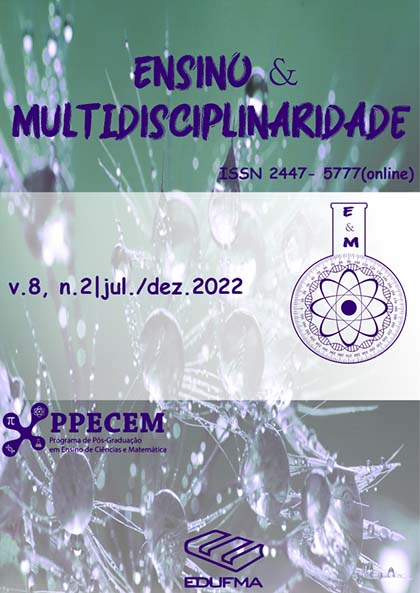Ansiedade à Matemática: Aspectos atitudinais e pressão social
DOI:
https://doi.org/10.18764/2447-5777v8n2.2022.8Palavras-chave:
Ansiedade à Matemática, Pressão, Fracasso escolarResumo
A Ansiedade à Matemática (AM) gera sofrimento emocional, sucessivos fracassos, fuga e evitação em estudantes adolescentes quando expostos à necessidade de aprender a disciplina. A partir de uma perspectiva de cognição social, o presente artigo discute alguns fatores interpessoais, contextuais e institucionais que, sob a forma de pressão, funcionam como gatilhos para o surgimento de AM, os quais, por sua vez, resultam em fracasso escolar. Discutem-se ainda as formas, muitas vezes sutis, de pressão na sala de aula e na escola, bem como em ambientes estendidos, a exemplo da família. Também são apresentados resultados relativos a pontos de corte da Escala de Ansiedade à Matemática e à distribuição de valores em uma amostra de estudantes do Ensino Médio de uma escola pública de Rondon do Pará, sudeste do Pará. A aplicação de critérios de corte com base em quartis da amostra é consistente com achados anteriores da literatura e pode permitir entender a relação entre AM, pressões interpessoais, contextuais e institucionais, e fracasso escolar. Observaram-se ainda maiores escores globais em meninas do que em meninos, o que pode estar relacionado a expectativas sociais e culturais sobre gênero e desempenho matemático. Sugerimos que olhar para aspectos culturais e sociais pode ajudar a compreender o fenômeno da AM e interferir sobre ele.
Math Anxiety: Attitudes and social pressure
Abstract
Math Anxiety (MA) generates emotional distress, successive failures, avoidance, and evasion in adolescent students when exposed to the need to learn mathematics. From the viewpoint of social cognition, the present article discusses interpersonal, contextual, and institutional factors that, in the form of pressure, act as triggers for the emergence of MA, which, in turn, result in school failure. The often subtle forms of pressure in the classroom and school, as well as in extended settings, such as the family, are also discussed. Results are also presented regarding the validation of the Math Anxiety Scale and their distribution in a sample of high school students from a public school in Rondon do Pará, southeastern Pará, Brazil. The application of cut-off criteria based on sample quartiles is consistent with previous findings in the literature, and may allow understanding the relationship between MA, interpersonal, contextual, and institutional pressures, as well as school failure. Higher overall scores were also observed in girls than in boys, which may be related to social and cultural expectations about gender and math performance. We suggest that looking at cultural and social aspects may help to understand the phenomenon of MA and interfere with it.
Downloads
Metrics
Referências
ALEXANDER, L.; COBB, R. Identification of the dimensions and predictors of mathematics anxiety among college students. Journal of Human Behavior and Learning, v. 4, p. 25-32, 1987.
ALEXANDER, L.; MARTRAY, C. R. The development of an abbreviated version of the Mathematics Anxiety Rating Scale. Measurement and Evaluation in Counseling and Development, v. 22, p. 143-150, 1989. https://doi.org/10.1080/07481756.1989.12022923
ARIFIN, W. N. Sample size calculator (web), 2022. Disponível em: https://wnarifin.github.io/ssc/ssalpha.html. Acesso em: 05 mar. 2022.
ASHCRAFT, M. H. Math anxiety: personal, educational, and cognitive consequences. Current Directions in
Psychological Science, v. 11, p. 181-185, 2002. https://doi.org/10.1111/1467-8721.00196
ASHCRAFT, M. H.; KIRK, E. P. The relationships among working memory, math anxiety, and performance. Journal of Experimental Psychology: General, v. 130, p. 224-237, 2001. https://doi.org/10.1037/0096-3445.130.2.224
ASHCRAFT, M. H.; KRAUSE, J. A.; HOPKO, D. R. Is math anxiety a mathematical learning disability? In: BERCH, D. B.; MAZZOCCO, M. M. M. (eds.). Why is math so hard for some children? The nature and origins of mathematical learning difficulties and disabilities. Baltimore: Paul H. Brookes Publishing Co., 2007. p. 329-348.
ASHKENAZI, S.; DANAN, Y. The role of mathematical anxiety and working memory on the performance of different types of arithmetic tasks. Trends in Neuroscience and Education, v. 7, p. 1-10, 2017. https://doi.org/10.1016/j.tine.2017.05.001
BALL, L. C.; CRIBBIE, R. A.; STEELE, J. R. Beyond gender differences: using tests of equivalence to evaluate gender similarities. Psychology of Women Quarterly, v. 37, p. 147-154, 14 jun. 2013. https://doi.org/10.1177/0361684313480483
BONETT, D. G. Sample size requirements for testing and estimating coefficient alpha. Journal of Educational and Behavioral Statistics, v. 27, p. 335-340, 2002. https://doi.org/10.3102/10769986027004335
BONG, M. Effects of parent-child relationships and classroom goal structures on motivation, help-seeking avoidance, and cheating. The Journal of Experimental Education, v. 76, p. 191-217, 2008. https://doi. org/10.3200/JEXE.76.2.191-217
BORTOLUZZO, A. B.; MATAVELLI, I. R.; MADALOZZO, R. Determinantes da distribuição da (des)igualdade de gênero entre os estados brasileiros. Estudos Econômicos, v. 46, p. 161-188, 2016. https://doi.org/10.1590/0101-416146115air
BRONSTEIN, P.; GINSBURG, G. S.; HERRERA, I. S. Parental predictors of motivational orientation in early adolescence: a longitudinal study. Journal of Youth and Adolescence, v. 34, p. 559-575, 2005. https://doi.org/10.1007/s10964-005-8946-0
CARMO, J. S. et al. Diferentes intensidades de ansiedade relatadas por estudantes do Ensino Fundamental II, em situações típicas do estudo da Matemática. In: SILVA, W. C. M. P. (ed.). Sobre comportamento e cognição: Aspectos teóricos, metodológicos e de formação em análise do comportamento e terapia cognitiva. Santo André: ESETEC, 2008. p. 213-221.
CARMO, J. S.; FERRAZ, A. C. T. Ansiedade relacionada à matemática e diferenças de gênero: uma análise da literatura. Psicologia da Educação, v. 35, p. 53-71, 2012.
DACHES COHEN, L.; RUBINSTEN, O. Mothers, intrinsic math motivation, arithmetic skills, and math anxiety in elementary school. Frontiers in Psychology, v. 8, p. 1839, 2017. https://doi.org/10.3389/fpsyg.2017.01939
DOBARRO, V. R.; BRITO, M. R. F. Atitude e crença de autoeficácia: relações com o desempenho em matemática. Educação Matemática, v. 12, p. 199-220, 2010.
DOWNEY, R. G.; KING, C. V. Missing data in Likert ratings: a comparison of replacement methods. The Journal of General Psychology, v. 125, p. 175-191, 1998. https://doi.org/10.1080/00221309809595542
DREGER, R. M.; AIKEN, L. R. Jr. The identification of number anxiety in a college population. Journal of Educational Psychology, v. 48, p. 344-351, 1957. https://doi.org/10.1037/h0045894
FASSIS, D.; MENDES, A. C.; CARMO, J. S. Diferentes graus de ansiedade à matemática e desempenho escolar no ensino fundamental. Psicologia da Educação, v. 39, p. 47-61, 2014.
FERNANDES, R. Índice de Desenvolvimento da Educação Básica (Ideb). Brasília, DF: Inep, 2007. Disponível em: http://www.rbep.inep.gov.br/ojs3/index.php/td/article/view/3850. Acesso em: 30 jan. 2023.
FIGUEIRA, P. V. S. T.; FREITAS, P. M. Relação entre ansiedade matemática, memória de trabalho e controle inibitório: uma meta-análise. Bolema: Boletim de Educação Matemática, v. 34, p. 678-696, 2020. https://doi.org/10.1590/1980-4415v34n67a16
GINSBURG, G. S.; BRONSTEIN, P. Family factors related to children’s intrinsic/extrinsic motivational orientation and academic performance. Child Development, v. 64, p. 1461-1474, 1993. https://doi.org/10.1111/j.1467-8624.1993.tb02964.x
GUHUR, M. L. P.; ALBERTO, R. N.; CARNIATTO, N. Influências biológicas, psicológicas e sociais do vestibular na adolescência. Roteiro, v. 35, p. 115-138, 2010.
HYDE, J. S. et al. Gender comparisons of mathematics attitudes and affect: a meta-analysis. Psychology of Women Quarterly, v. 14, p. 299-324, 1990. https://doi.org/10.1111/j.1471-6402.1990.tb00022.x
INEP [INSTITUTO NACIONAL DE ESTUDOS E PESQUISAS EDUCACIONAIS ANÍSIO TEIXEIRA]. Brasil no Pisa 2018. Brasília, DF: Inep, 2020.
INEP [INSTITUTO NACIONAL DE ESTUDOS E PESQUISAS EDUCACIONAIS ANÍSIO TEIXEIRA]. Resultados do Índice de Desenvolvimento da Educação Básica 2019. Resumo técnico. Brasília, DF: Inep, 2021. Disponível em: https://www.gov.br/inep/pt-br/areas-de-atuacao/pesquisas-estatisticas-e-indicadores/ideb/resultados. Acesso em: 30 jan. 2023.
LEE, J. Universals and specifics of math self-concept, math self-efficacy, and math anxiety across 41 PISA 2003 participating countries. Learning and Individual Differences, v. 19, p. 355-365, 2009. https://doi.org/10.1016/j.lindif.2008.10.009
MENDES, A. C. Identificação de graus de ansiedade à Matemática em estudantes do ensino fundamental e médio: contribuições à validação de uma escala de ansiedade à Matemática. 2012. Dissertação (Mestrado em Psicologia) – Centro de Educação e Ciências Humanas, Universidade Federal de São Carlos, São Carlos, 2012.
MENDES, A. C. Ansiedade à matemática: evidências de validade de ferramentas de avaliação e intervenção. 2006. Tese (Doutorado em Psicologia) – Centro de Educação e Ciências Humanas, Universidade Federal de São Carlos, São Carlos, 2016.
MENDES, A. C.; CARMO, J. S. Estudantes com grau extremo de ansiedade à matemática: Identificação de casos e implicações educacionais. Psicologia da Educação, v. 33, p. 119-133, 2011.
MOURA-SILVA, M. G. Manifestações subjacentes da ansiedade matemática no sistema nervoso autônomo: uma análise da variabilidade da frequência cardíaca, desempenho matemático e função executiva em crianças escolares. 2019. Tese (Doutorado em Educação em Ciências e Matemáticas) – Instituto de Educação Matemática e Científica, Universidade Federal do Pará, Belém, 2019.
OECD [ORGANIZAÇÃO PARA A COOPERAÇÃO E DESENVOLVIMENTO ECONÔMICO]. Resumo de resultados nacionais do PISA 2015 - Brasil. Paris: OECD, 2016.
PLAKE, B. S.; PARKER, C. S. The development and validation of a revised version of the mathematics anxiety rating scale. Educational and Psychological Measurement, v. 42, p. 551-557, 1982. https://doi.org/10.1177/001316448204200218
PLETZER, B. et al. Components of mathematics anxiety: factor modeling of the MARS30-Brief. Frontiers in Psychology, v. 7, p. 91, 2016. https://doi.org/10.3389/fpsyg.2016.00091
POLYDORO, S.; GUERREIRO-CASANOVA, D. C. Escala de autoeficácia acadêmica para o Ensino Médio: busca de evidências psicométricas. Estudos Interdisciplinares em Psicologia, v. 6, p. 36-53, 2015.
ROUNDS, J. B.; HENDEL, D. D. Measurement and dimensionality of mathematics anxiety. Journal of Counseling Psychology, v. 27, p. 138-149, 1980. https://doi.org/10.1037/0022-0167.27.2.138
SUINN, R. M.; TAYLOR, S.; EDWARDS, R. W. The suinn mathematics anxiety rating scale (MARS-E) for Hispanic elementary school students. Hispanic Journal of Behavioral Sciences, v. 11, p. 83-90, 1989. https://doi.org/10.1177/07399863890111007
TAYLOR, B. A.; FRASER, B. J. Relationships between learning environment and mathematics anxiety. Learning Environments Research, v. 16, p. 297-313, 2013. https://doi.org/10.1007/s10984-013-9134-x
TOBIAS, S. Overcoming math anxiety. Nova York: W. W. Norton & Company, 1978.
TURNER, J. C. et al. The classroom environment and students’ reports of avoidance strategies in mathematics: a multimethod study. Journal of Educational Psychology, v. 94, p. 88-106, 2002. https://doi.org/10.1037/0022-0663.94.1.88
Downloads
Publicado
Como Citar
Edição
Seção
Licença
Copyright (c) 2023 Ensino & Multidisciplinaridade

Este trabalho está licenciado sob uma licença Creative Commons Attribution 4.0 International License.
Autores que publicam nesta revista concordam com os seguintes termos:
a. Autores mantém os direitos autorais e concedem à revista o direito de primeira publicação, com o trabalho simultaneamente licenciado sob a Licença Creative Commons CC BY que permite o compartilhamento do trabalho com reconhecimento da autoria e publicação inicial nesta revista.
b. Autores têm autorização para assumir contratos adicionais separadamente, para distribuição não-exclusiva da versão do trabalho publicada nesta revista (ex.: publicar em repositório institucional ou como capítulo de livro), com reconhecimento de autoria e publicação inicial nesta revista.
c. Autores têm permissão e são estimulados a publicar e distribuir seu trabalho online (ex.: em repositórios institucionais ou na sua página pessoal) após a publicação final do manuscrito.




















